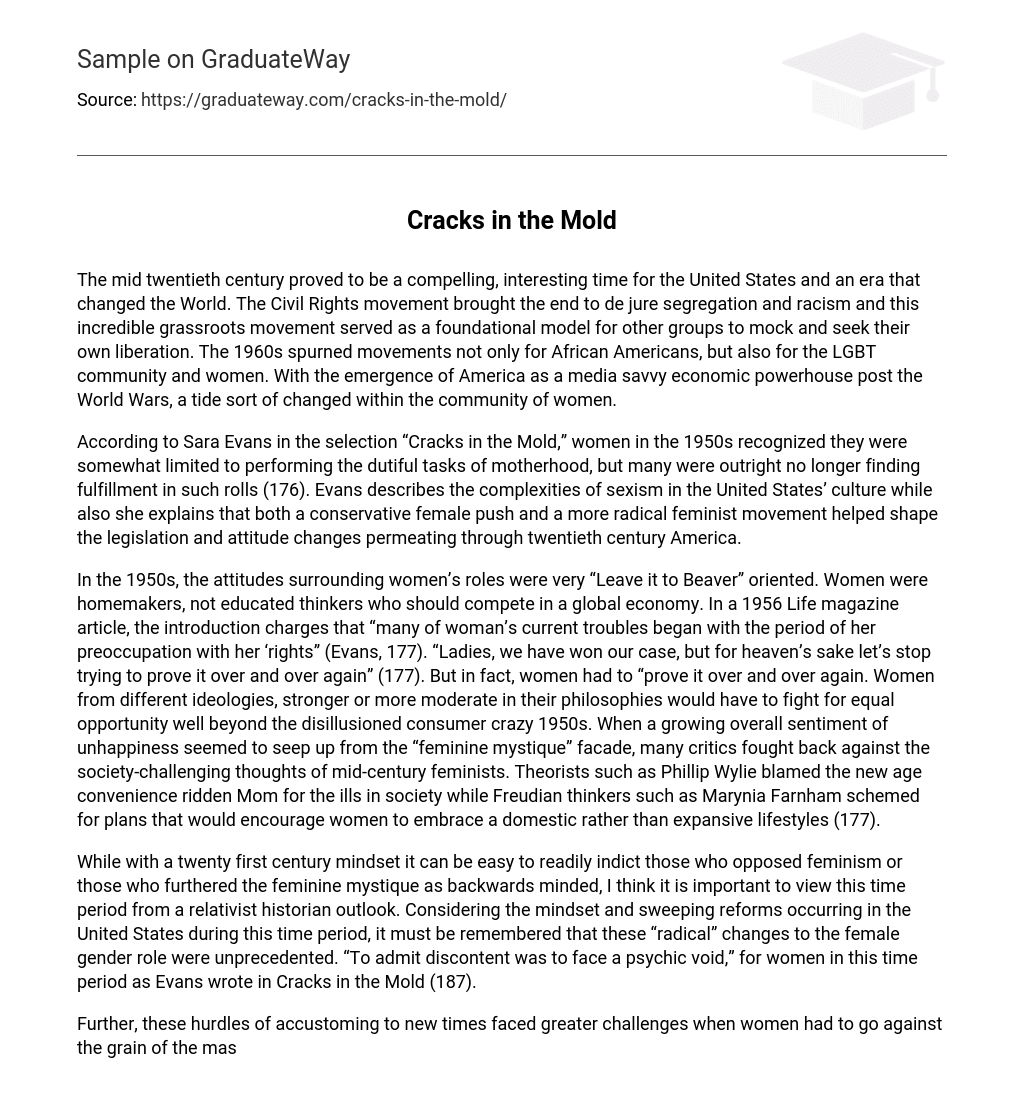The mid twentieth century in the United States was a captivating and revolutionary time that had a profound impact worldwide. The Civil Rights movement played a crucial role in eliminating legal segregation and racism, inspiring other marginalized communities to seek their own freedom. In the 1960s, activism arose not only among African Americans but also within the LGBT community and women. Additionally, America’s emergence as a media-savvy economic force after the World Wars caused significant changes in women’s social standing.
In her discussion, Sara Evans (176) explores the discontent experienced by numerous women in the 1950s concerning their motherly roles, even though they recognized the constraints imposed on them. She emphasizes the pervasiveness of sexism within American society during that era and examines how both conservative women and radical feminists played pivotal roles in molding laws and transforming societal viewpoints throughout the twentieth century.
In the 1950s, women were expected to be homemakers and not educated thinkers who could compete in the global economy. According to a Life magazine article from 1956, women’s troubles started when they became preoccupied with their rights. The article acknowledges that women had won their case but advises them to stop trying to prove it repeatedly. However, women still had to continue proving their worth. Women with different ideologies fought for equal opportunities beyond the consumer-driven 1950s. Critics pushed back against mid-century feminists’ challenging ideas as discontent grew among women. Theorists like Phillip Wylie blamed convenience-driven mothers for societal problems, while Freudian thinkers like Marynia Farnham urged women to embrace domestic lifestyles instead of expanding their horizons.During the conservative era of consumerism in the 1950s and onwards, diverse groups of women with different beliefs had to come together to fight for gender equality in society. They went beyond societal expectations at that time to seek equal opportunities. As dissatisfaction among females became more evident, critics emerged as opposition to the feminist movements of that time. Influential theorists like Phillip Wylie attributed some societal issues to convenience-seeking mothers, while Freudian scholars such as Marynia Farnham encouraged embracing a domestic lifestyle rather than pursuing broader horizons.
While it may be tempting to critique those who resisted feminism or perpetuated the feminine mystique from a contemporary viewpoint, it is essential to approach this era with a relativist historian perspective. It is crucial to keep in mind that during this time, the United States was experiencing substantial changes and reforms, specifically regarding gender roles. These changes were perceived as drastic and unprecedented. As stated by Evans in Cracks in the Mold (187), women during this period had to confront a deep emptiness when acknowledging their dissatisfaction.
Additionally, overcoming these obstacles of adapting to new societal norms became even more difficult for women as they had to counteract the influence of mass media. Despite an increasing number of women pursuing higher education and entering the workforce, the mass media continued to promote the idea that domesticity was the ultimate achievement (Evans, 178). Similar to various aspects of American history, this influence of the media remains prevalent even in the present day of the 21st century, as it determines what is considered socially acceptable or unacceptable.
Female magazines showcased glamorous accessories, decorations, and feminine fashion that were more provocative and suggestive than ever before. This advertising frenzy greatly contributed to the booming capitalist economy of the United States. Alongside these advertisements, various consumer household goods were marketed, including laundry detergents, odor-free kitchens, and even “Poppin’ fresh” breads (178). Adlai Stevenson aptly summarized the aspirations of the average woman: to create a vision of the true essence of life and freedom within her own home…
The text emphasizes the importance of helping women’s husbands find meaning in their daily tasks and teaching their children to appreciate the distinctiveness of every individual. This perspective, prevalent in the 1950s, soon faced opposition as women actively pursued equality and made significant progress in society and law. This progressive mindset ultimately dismantled the pedestal on which the concept of feminine mystique was built.
Ten years later, Life magazine began featuring articles that centered on “working mothers” as opposed to the traditional portrayal of contented housewives (183). The concept of contented housewives was no longer widely embraced by society. With John Kennedy’s presidential victory in 1960, there was an overall shift towards a more optimistic outlook on change (184). Consequently, the media also altered their role and became proponents for change. Rather than endorsing the notion of stay-at-home mothers, mass media emphasized the difficulties encountered by housewives who felt confined within their domestic responsibilities.
In 1964, the implementation of Title VII marked a significant victory for feminists as it prohibited workplace discrimination based on sex. Women in general embraced the idea of equal opportunity and meritocracy. Nonetheless, within the feminist movement, two factions emerged. Professional women who had already established themselves in their careers during the rise of feminism adopted a more moderate approach, primarily concentrating on women’s rights and attaining legal triumphs.
Sara Evans asserts that although these women made significant contributions to advancing equality in the public sphere, their efforts were restricted because they chose not to challenge the mainstream. Evans argues that true change necessitated questioning the entire system as gender roles were deeply ingrained in every aspect of society. In comparison, younger women had a more influential role in driving the female revolution.
These women faced conflicting messages in their lives and dedicated themselves to fighting against sexism in both private homes and public policies. Women from various backgrounds and political viewpoints played a vital role in advocating for the rights of women. This period saw a notable revival of feminism as these women, inspired by their participation in the Civil Rights movement, led a grassroots movement within their marginalized community.





